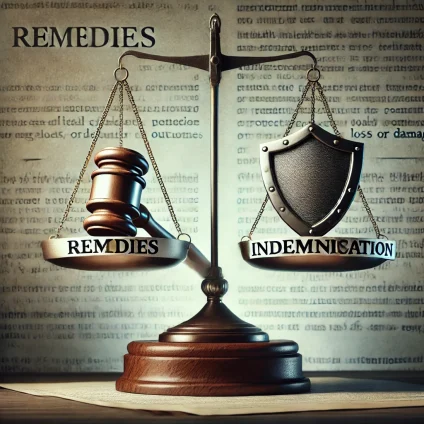Copyright 2024 by Mark Cohen, J.D., LL.M.
I recently saw this provision in a mutual nondisclosure agreement:
1. The Recipient shall be responsible for any breach of this Agreement by the Recipient and its Representatives. The Recipient acknowledges and agrees that any disclosure of the Confidential Information except as provided in this Agreement may cause serious and irreparable damage to the Disclosing Party for which there may be no adequate remedy at law. Without limiting the Disclosing Party’s rights and remedies which are otherwise available, the Disclosing Party shall be entitled to seek equitable relief including, without limitation, an injunction, restraining order or specific performance for any breach of this Agreement by the Recipient. The Recipient waives any securing or posting of any bond in connection with such remedy. In addition, each Party shall indemnify, defend, and hold the other party harmless from and against any and all claims, losses, defenses, actions, causes of action, damages, costs or expenses, including reasonable attorneys’ fees and any other costs, both direct and indirect, asserted, claimed, or caused, if and to the extent the same arises in whole or in part, directly or indirectly, from any breach of this Agreement by that party. (Italics mine).
I will ignore the redundancy in phrases such as “acknowledges and agrees” and “securing and posting.” I will ignore the unnecessary “which are” and “by the Recipient.” I will ignore that the drafter wrote “may cause serious and irreparable damage” rather than “will cause serious and irreparable damage.” I will ignore that the Flesch-Kincaid grade level for this provision is 20.1. I will ignore the 20% passive voice sentence rate. I want to focus on the italicized portion of this provision because it’s a good example of confusing remedies for breach with indemnification.
Though the non-italicized portion is needlessly verbose, most lawyers and judges would agree on its meaning. The gist is that if one party believes the other breached the agreement, the aggrieved party may seek injunctive relief without posting bond. Then we get to the italicized portion.
My first criticism of the italicized portion is that it does not belong in the contract’s “Remedies” section. It belongs in a separate “Indemnification” section. For an example of how including unrelated provisions under a single heading may cause problems, see Haynes v. Farmers Inc. Exchange, 89 P.3d 381, 385 (Cal. 2004) (Court did not enforce a provision limiting coverage in a section labeled “Other Insurance”).
My second criticism of the italicized portion is that the drafter did not clearly limit it to third-party claims. Indemnity provisions traditionally addressed only claims by third parties (third-party claims). Regency Realty Inv’rs, LLC v. Cleary Fire Prot., Inc., 260 P.3d 1, 7 (Colo.App.2009). However, an indemnity provision may apply to claims between the parties (first-party claims) if the provision clearly applies to first-party claims or is written so broadly that a court interprets it that way. See Hot Rods, LLC v. Northrop Grumman Sys. Corp., 242 Cal. App. 4th 1166, 1170 (Cal.App.2015); Hooper Assocs., Ltd. v. AGS Computers, Inc., 74 N.Y.2d 487 (N.Y. 1989).
Here, the italicized provision is not limited to third-party claims. As written, most courts would interpret it to also apply to first-party claims. See Hot Rods, supra. If the italicized provision applies to first-party claims, it may conflict with other contractual provisions such as those that limit damages. It may also offer the party claiming breach a way to recover attorney’s fees even if there is no “loser pays” attorney’s fees provision in the contract.
My third criticism of the italicized provision is the use of “hold harmless.” Not all courts agree on what “hold harmless” means. Most courts treat “indemnify” and “hold harmless” as synonymous, but some hold the words imply different obligations. See, e.g., Queen Villas Homeowners Ass’n v. TCB Prop. Mgmt., 56 Cal. Rptr. 3d 528, 534 (Cal. Ct.App. 2007) (“Indemnify” is an offensive right allowing an indemnitee to seek indemnification. “‘Hold harmless’” is defensive: the right not to be bothered by the other party itself seeking indemnification.).
The routine inclusion of “hold harmless” can lead to litigation over whether the indemnitor must advance defense costs to the indemnitee. See, e.g., Majkowski v. Am. Imaging Mgmt. Servs., LLC, 913 A. 2d 572 (Del. Ch. 2006). “Hold harmless” may also open the door to claims that one party released the other from responsibility for its acts or omissions. See, e.g., Rooz v. Kimmel, 55 Cal.App.4th 573, 582 (1997) (hold harmless provision prevented plaintiff from recovering damages resulting from defendant’s negligence). See also United States v. Contract Mgmt., Inc., 912 F. 2d 1045 (9th Cir. 1990).
If “indemnify” and “hold harmless” are synonymous, “hold harmless” is unnecessary in an indemnity provision. If they are not, lawyers who include “hold harmless” without understanding why run the risk of unintended consequences. The better practice is not to include “hold harmless” unless the parties intend it to signify a release from liability.






